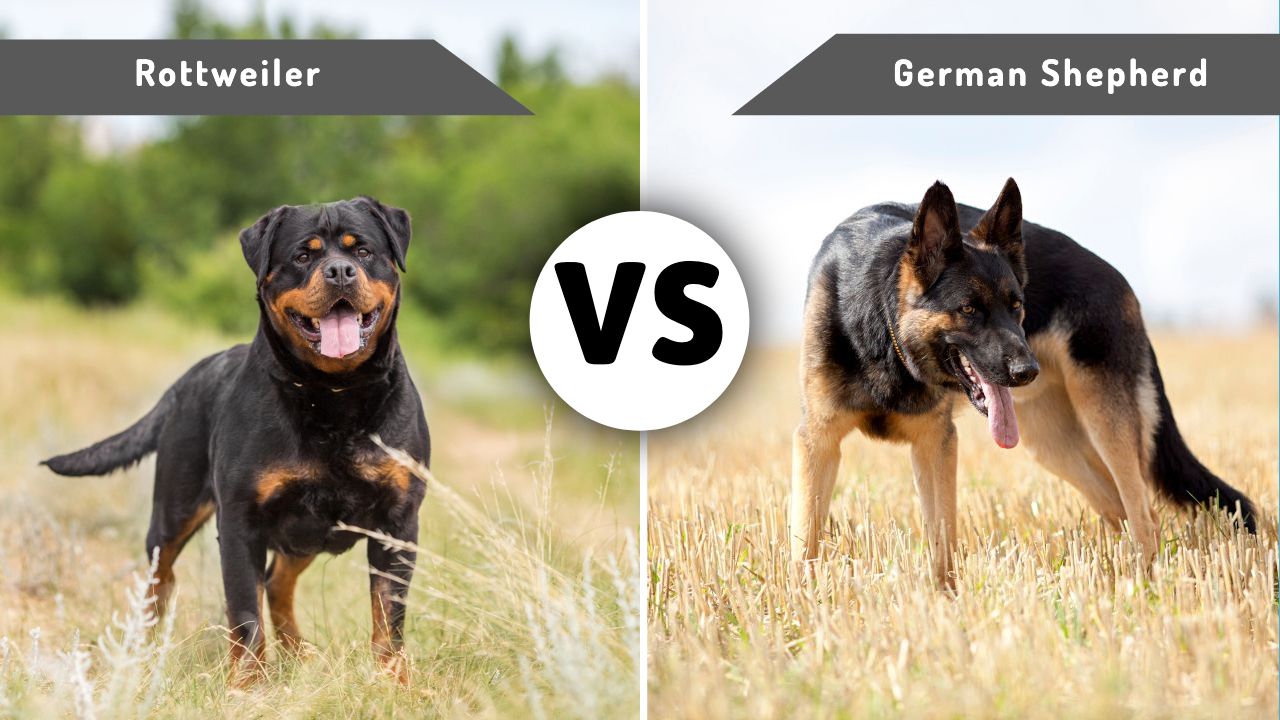
Greetings to all dog lovers and pet enthusiasts! Today, we are going to delve into an intriguing comparison that has often sparked discussions among dog owners and enthusiasts alike – the comparison between the Rottweiler and the German Shepherd.
Both Rottweilers and German Shepherds are breeds that command respect due to their striking appearance and strong presence. They are well-renowned worldwide, not only for their physical prowess but also for their intelligence, versatility, and unwavering loyalty.
The Rottweiler, with its robust build and distinctive black-and-tan coloring, has a commanding presence that is hard to ignore. On the other hand, the German Shepherd, known for its sharp intellect and working dog reputation, also holds a prestigious spot in the canine world.
But which of these breeds is the right fit for you? Is the affable and protective nature of the Rottweiler more your speed, or would the energetic and intelligent German Shepherd better match your lifestyle?
In this comprehensive comparison, we will explore their origins, physical attributes, temperaments, health, and care requirements. Our aim is to provide you with detailed insights that can help you make an informed choice about which breed would be the best fit for your home. Let’s dive right in!
Stay tuned as we embark on this fascinating journey exploring these two popular dog breeds: the Rottweiler and the German Shepherd.
You May Also Like: German Shepherd Price
| BREED COMPARISON | ||
|---|---|---|
| Rottweiler | German Shepherd | |
| Weight | 80 - 135 pounds | 50 - 90 pounds |
| Height | 22 - 27 inches | 22 - 26 inches |
| Size | Medium to large | Medium to large |
| Temperament | Loyal, protective, courageous | Intelligent, loyal, courageous |
| Trainability | 4.0 out of 5.0 stars4.0 | 5.0 out of 5.0 stars5.0 |
| Energy Level | 4.0 out of 5.0 stars4.0 | 5.0 out of 5.0 stars5.0 |
| Life Expectancy | 9 - 10 years | 7 - 10 years |
| Shedding | 3.0 out of 5.0 stars3.0 | 5.0 out of 5.0 stars5.0 |
| Hypoallergenic | No | No |
| Puppy Costs | $1,500 - $4,000 | $800 - $10,000 |
| Suitable For | Rottweilers are quite adaptable and can thrive in different living situations, be it a house with a big yard or an apartment, provided they get enough exercise. However, they prefer having access to a secure outdoor space where they can patrol and play. | German Shepherds, given their high energy levels and active nature, are best suited to homes where they have plenty of space to run and play. They aren't the best dog for apartment living unless the owner is committed to providing substantial daily exercise. |
Rottweiler vs. German Shepherd: Origins and History
When it comes to understanding dog breeds, a look into their past often offers invaluable insight into their present behaviors, traits, and characteristics. Let’s explore the backgrounds of our two breeds of interest.
Origin of Rottweilers: A Rich History
The Rottweiler’s origins can be traced back to the Roman Empire. Rottweilers descended from the Molossus, a mastiff-type dog, which the Romans used as herding dogs to herd cattle that fed the Roman legions marching across Europe. As the Romans traversed across regions, the Molossus bred with local dogs, leading to different iterations of the breed.
One of the areas these Roman legions passed through was a town in Southwestern Germany known as ‘Rottweil’—from which the breed gets its name. The ‘Rottweiler Metzgerhund,’ translating to the ‘Butcher’s Dog of Rottweil,’ was a trusted aide to butchers, used to drive cattle to markets and guard the money pouches tied around their necks.
However, with the rise of rail transport in the 19th century, the breed’s herding role diminished. Nevertheless, Rottweilers found new employment as police dogs, guard dogs, and family guardians due to their strength, intelligence, and loyalty.
Origin of German Shepherds: The Versatile Workers
The German Shepherd breed, as the name suggests, originated in Germany in the late 19th century. Max von Stephanitz, a former student of the Berlin Veterinary College, is credited as the ‘father’ of the German Shepherd breed. He envisioned a versatile, intelligent, and hardworking dog breed that could excel at herding.
One day, at a dog show, Stephanitz spotted a dog named Hektor Linksrhein that embodied all the qualities he sought. He purchased Hektor, renamed him Horand von Grafrath, and founded the Verein für Deutsche Schäferhunde, the Society for the German Shepherd Dog. Horand became the first registered German Shepherd, marking the start of the breed.
German Shepherds gained popularity and recognition for their remarkable skills during World War I, where they served as military dogs performing tasks such as message carrying, locating wounded soldiers, and guarding installations. Their invaluable contributions further elevated their reputation.
Author Note: This brief glimpse into their histories illustrates how both breeds were bred for work, requiring intelligence, strength, and a strong bond with their human counterparts.
Comparing Physical Appearance and Characteristics

Rottweiler: The Powerhouse
Rottweilers are muscular and robust, often characterized by their broad chests and substantial bodies. They stand between 22 to 27 inches tall at the shoulder and typically weigh anywhere from 80 to 135 pounds, depending on the dog’s gender and overall health.
Rotties have a distinct black coat with rust to mahogany markings on the muzzle, cheeks, chest, legs, and above the eyes. They also have a medium-length double coat that is straight, coarse, and dense, providing them with adequate protection against harsh weather.
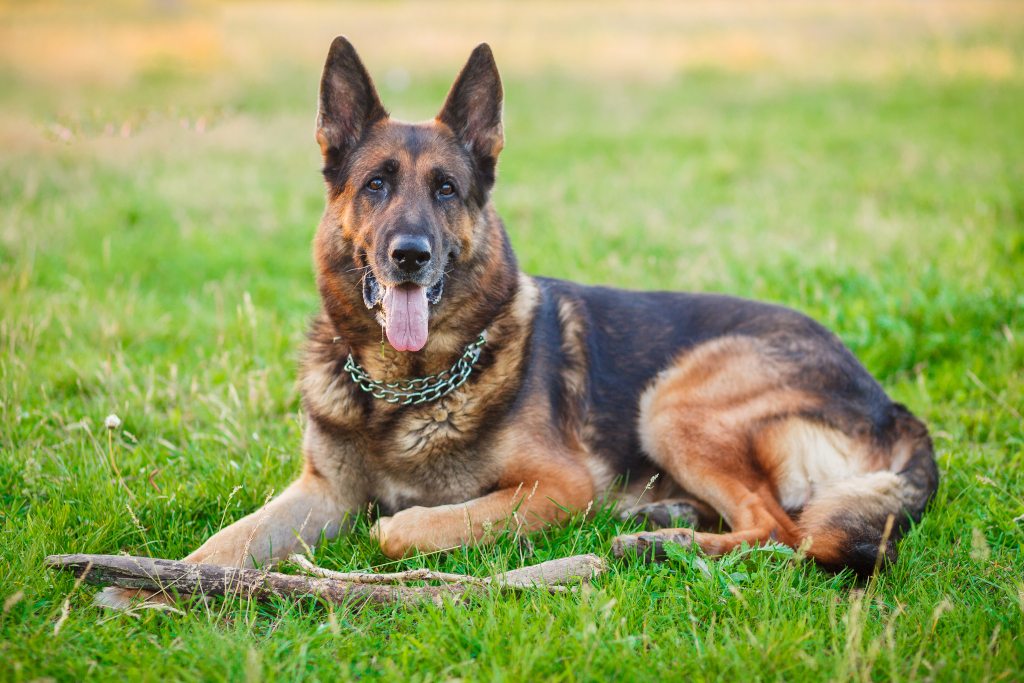
German Shepherd: Agile and Athletic
German Shepherds, on the other hand, have a more elongated build. Male German Shepherds usually stand about 24 to 26 inches tall and weigh between 65 and 90 pounds, while female GSDs are slightly smaller, standing about 22 to 24 inches tall and weighing between 50 and 70 pounds.
German Shepherds have a double coat like Rottweilers, but theirs can either be medium or long in length, with a dense outer coat and a softer undercoat. Their coats come in a variety of colors, including black, black and tan, sable, and bi-color. One of the most distinctive features of a German Shepherd is its firm, direct gaze, emanating intelligence and confidence.
You May Also Like: All Types Of German Shepherds
Comparison: While Rottweilers seem more formidable due to their bulk, German Shepherds are equally strong, characterized by their agility and speed. Another distinctive difference is in the way they move. A Rottweiler's gait is balanced and steady, while a German Shepherd has a smooth, flowing gait that seems almost effortless but is ready to spring into action instantly.
Temperament and Personality
Rottweiler: Confident, Protective, and Loyal
Rotties are often described as confident, courageous, and calm. They possess a natural instinct to protect their homes and families, making them excellent guardians.
However, they’re not just all about work. When they’re not on duty, Rottweilers can be gentle playmates and love being part of family activities. They’re also known for their loyalty and tend to form strong bonds with their families.
Rottweilers may be reserved with strangers but are not typically aggressive without reason. However, it’s essential to remember that their protective nature can lead to problems if they’re not correctly socialized and trained from an early age.
German Shepherd: Intelligent, Courageous, and Alert
German Shepherds are known for their intelligence, making them one of the easiest breeds to train. They’re keen learners and love challenges, which is why they excel in various roles, such as service, search and rescue, and police work.
German Shepherds are also protective of their family and can be aloof towards strangers but warm up once they realize there is no threat. These dogs are energetic and enjoy having tasks to do, and they can become destructive if not given enough mental and physical stimulation.
Comparison: Rottweilers and German Shepherds have distinct yet overlapping temperaments. Rottweilers are known for their confidence, loyalty, and protective nature. They are typically reserved and cautious with strangers, making them excellent guard dogs. German Shepherds are highly intelligent, loyal, and versatile. GSDs tend to be more outgoing, and Rotties are gentler with children.
Training and Exercise Needs
When it comes to training and exercise, both the Rottweiler and the German Shepherd have their unique requirements. Understanding these is critical to meeting their mental and physical needs.
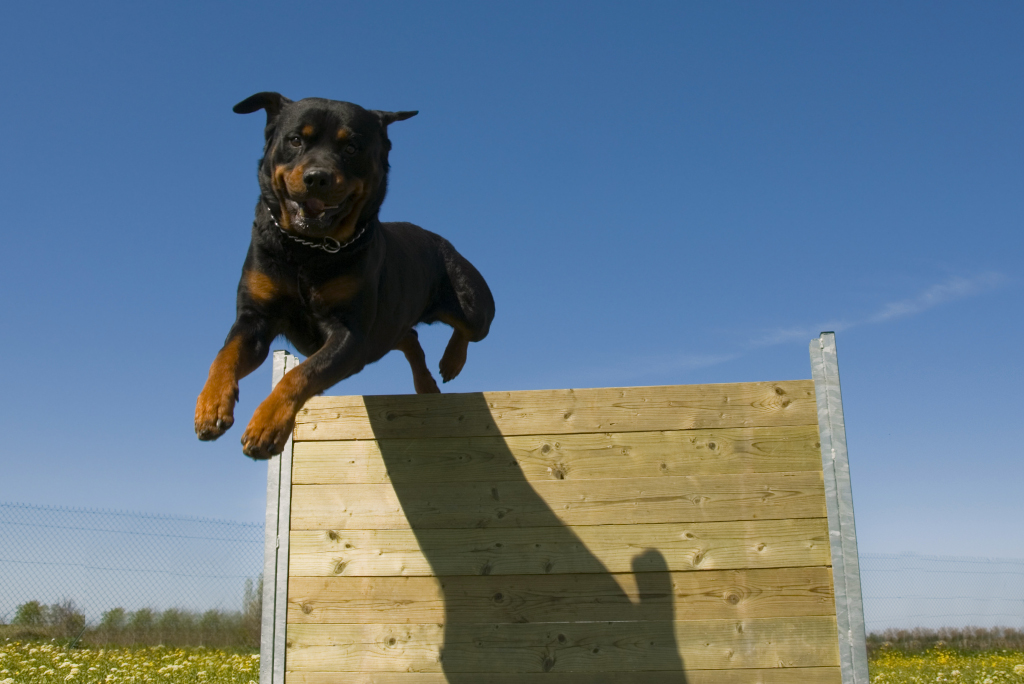
Rottweiler
Rottweilers are intelligent and eager to please, making them relatively easy to train. They respond best to consistent, positive reinforcement methods, for instance, dog clicker training. They are also known for their strong will, so it’s essential to establish clear boundaries and leadership from a young age.
Physical exercise is vital for a Rottweiler’s health and happiness. A daily walk or jog, coupled with some playtime in the yard or a park, usually suffices. However, mental stimulation is just as important. Training sessions, puzzle toys, and games that encourage them to think can help keep their minds sharp.
You May Also Like: Guide to Building a Backyard Dog Run
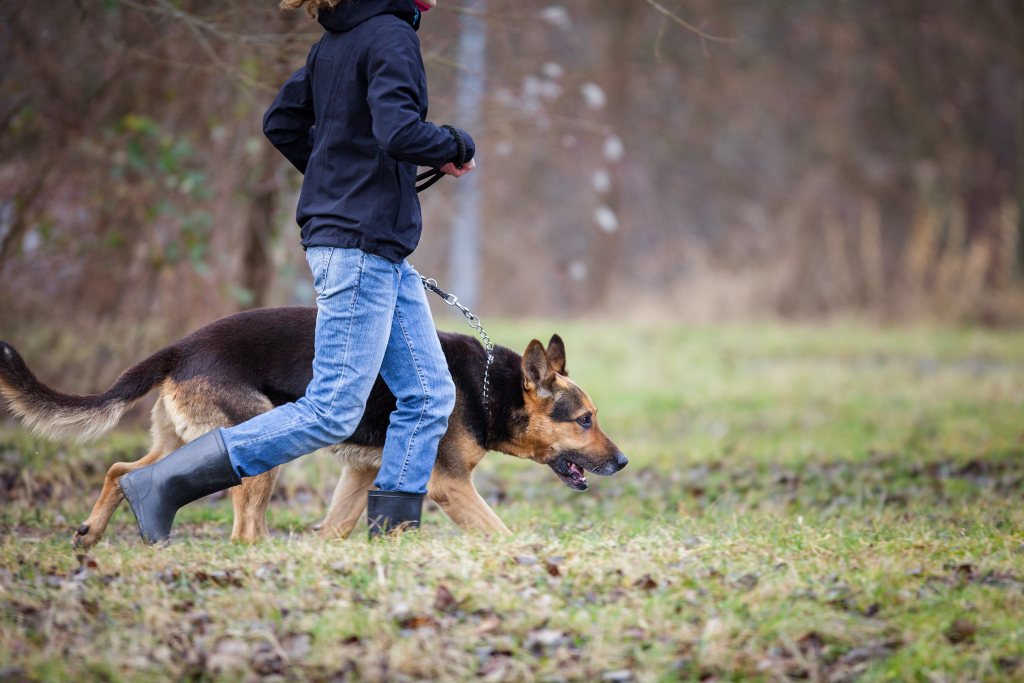
German Shepherd
GSDs are one of the most intelligent dog breeds and are known for their eagerness to learn. They thrive on structured training and are quick to pick up new commands and tricks, and they also respond well to positive reinforcement training methods.
Being an active and energetic breed, German Shepherds require a significant amount of exercise. This can include bike riding with their owner, jogging around the neighborhood, hiking in the woods, or a long brisk walk. If they don’t get enough exercise, they may become bored and exhibit destructive behavior.
As with Rottweilers, German Shepherds also need mental stimulation. Training that engages their mind, interactive toys, and mentally challenging games can help satisfy this need.
You May Also Like: 7 Popular Dog Training Methods: Which One Suits You Best?
Key Takeaways: Both Rottweilers and German Shepherds are intelligent breeds that thrive on positive reinforcement training. They both require mental stimulation and benefit greatly from consistent, structured training. The main difference lies in their exercise needs. While Rottweilers and German Shepherds are high-energy dogs that need plenty of exercise and mental stimulation, the former can get by with a bit less exercise than the latter.
Common Health Issues and Average Lifespan
Every breed has certain health conditions they’re genetically more prone to, and both Rottweilers and German Shepherds are no exception. Let’s delve into the primary health concerns and expected life spans for these breeds.
Rottweiler
Rottweilers have an average lifespan of around 9-10 years.
Despite their sturdy appearance, they are prone to several health issues. These include hip and elbow dysplasia, heart conditions such as aortic stenosis and dilated cardiomyopathy, and certain types of cancer like osteosarcoma. They can also be prone to obesity if not provided with a balanced diet and regular exercise.
Regular vet check-ups, a healthy diet, and an active lifestyle are the best ways to ensure your Rottweiler lives a long, healthy life.
You May Also Like: Help, My Dog Won’t Sleep
German Shepherd
German Shepherds typically live between 7-10 years.
They are susceptible to certain health problems, including elbow and hip dysplasia, which can lead to arthritis in older age. They’re also prone to a condition called degenerative myelopathy, a severe spinal cord disease. Additionally, they can suffer from bloat (gastric dilatation-volvulus), which can become a life-threatening condition if not treated promptly.
Like Rottweilers, maintaining a German Shepherd’s health requires regular vet visits, a well-balanced diet, and plenty of exercises.
You May Also Like: Why Do Dogs Chew On Their Feet?
Key Takeaways: Both Rotties and GSDs are generally healthy dogs. And when comparing the health of these breeds, they both have risks for certain conditions, primarily hip and elbow dysplasia. Rottweilers may live slightly longer on average, but individual health can vary greatly within each breed. Regardless of breed, purchasing your puppy from a responsible breeder, regular veterinary care, proper nutrition, and ample exercise are key to promoting a long, healthy life for any dog.
Diet and Nutritional Requirements: Rottweiler vs. German Shepherds
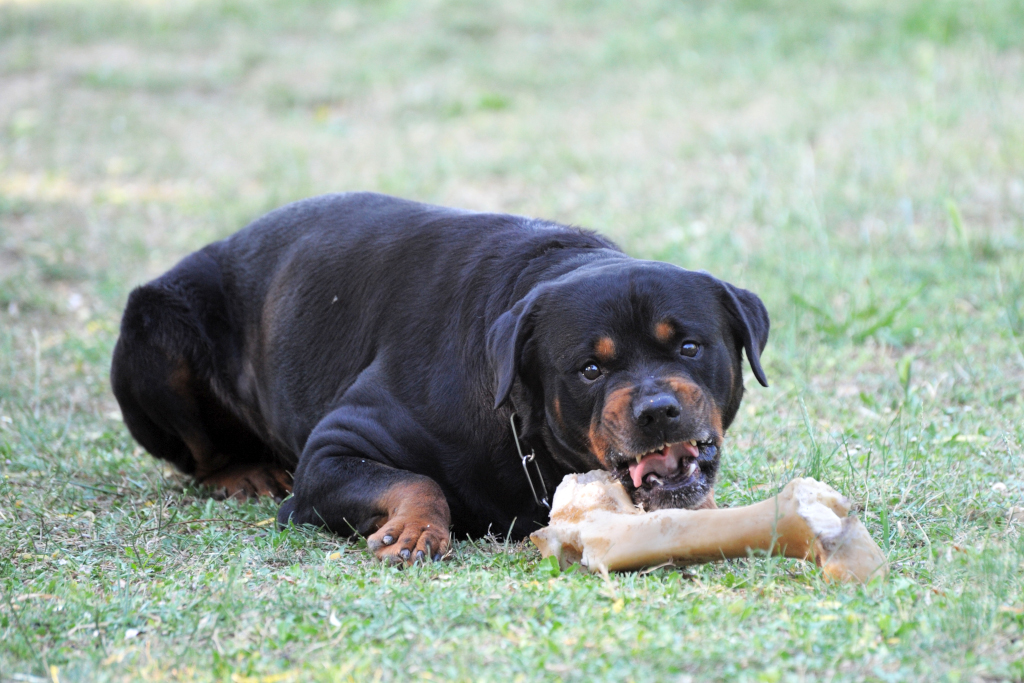
Rottweiler
Rottweilers are large and robust dogs that require a diet high in protein to support their muscular build. They also need a balanced amount of fats for a healthy coat and skin and complex carbohydrates for energy. An adult Rottweiler’s diet should consist of about 22-26% protein and 12-16% fat. Their diet should also include essential vitamins and minerals to ensure proper growth and development.
High-quality dry kibble and wet food are both good options for feeding a Rottie as long as they contain protein from meat sources and are enriched with vitamins and minerals. And due to their predisposition towards obesity and certain health conditions, monitoring their calorie intake is crucial, and dog treats should be given sparingly.
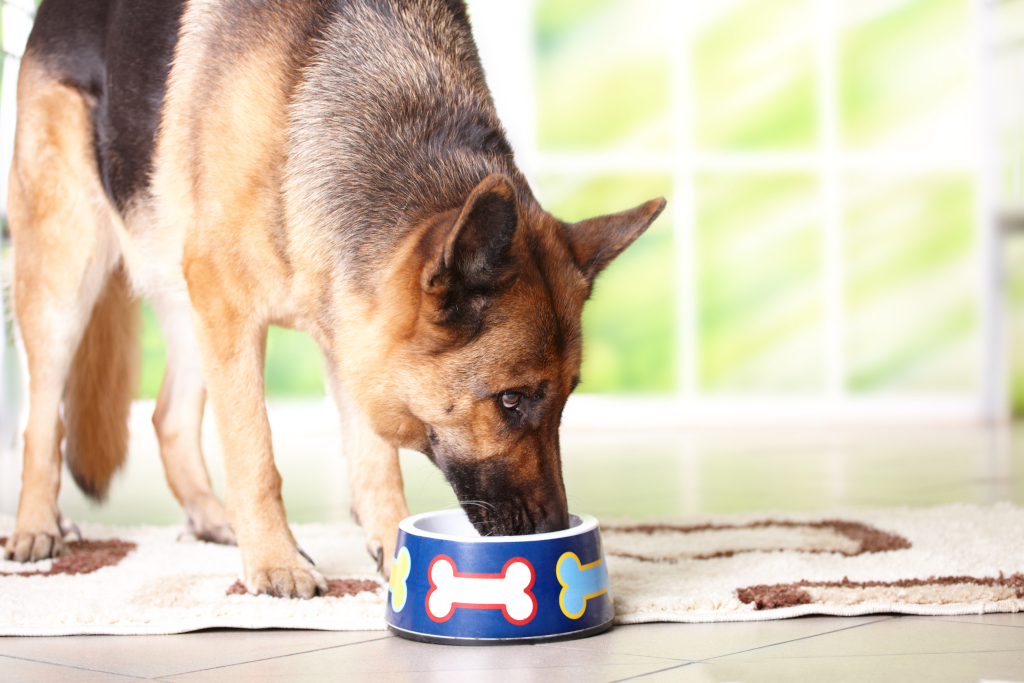
German Shepherd
German Shepherds also have specific dietary requirements that should be met to ensure their optimal health. Typically, their diet should contain around 18-22% protein derived from high-quality animal sources such as chicken, beef, or fish. Additionally, moderate amounts of healthy fats are necessary to provide energy and support a healthy coat and skin.
When selecting dog kibbles, you’ll want to choose one specifically formulated for German Shepherds, as these products often contain ingredients tailored to their unique needs to ensure the right balance of nutrients.
You May Also Like: Help, My Dog Won’t Eat
Key Takeaways: Due to their different body structure and activity levels, their dietary needs may differ slightly. Rottweilers need a careful balance to prevent obesity, while German Shepherds need a diet catering to their high energy levels.
Grooming Needs: Rottweiler vs. German Shepherds
Rottweiler: Low-Maintenance Grooming
Rottweilers have a short, straight coat that is relatively easy to maintain. Regular brushing, about once a week, will help to remove loose fur and keep their coat looking its best. Rottweilers are not heavy shedders, but they do experience a seasonal shed, usually in the spring and fall, during which more frequent brushing will be needed.
Bathing should be done as needed, typically every few months, unless the dog gets particularly dirty. Regular ear checks and cleaning, as well as teeth cleaning, should also be part of their grooming routine. As with all breeds, nail trimming is important and should be done as often as necessary to keep their nails at a manageable length.
You May Also Like: Best Dog Paw Cleaner
German Shepherd
German Shepherds, with their medium-length hair, require more grooming. Their coat is dense and sheds year-round, with heavier shedding periods in spring and fall. They benefit from regular brushing several times a week to help manage shedding and keep their coats healthy.
Like Rottweilers, bathing can be done as needed, usually every few months. Regular ear checks and teeth cleaning are also crucial for German Shepherds. Their nails should be trimmed regularly, usually once every two to four weeks, to prevent overgrowth and splitting.
You May Also Like: Best Dog Dry Shampoo
Key Takeaways: While both breeds require grooming to keep them looking their best, German Shepherds require more frequent brushing due to their double coats and tend to shed more than Rottweilers. Both breeds benefit from regular ear checks, teeth cleaning, and nail trims.
German Shepherd vs. Rottweiler: Ideal Homes and Owners
Rottweiler: A Balanced Environment
Rottweilers are quite adaptable and can thrive in different living situations, be it a house with a big yard or an apartment, provided they get enough exercise. However, they prefer having access to a secure outdoor space where they can patrol and play.
Rottweilers are family-oriented and enjoy being involved in family activities. They do well in homes where they are treated as a part of the family rather than just a guard dog. Rottweilers can live with children and other pets if properly socialized from a young age, though interactions with smaller children should always be supervised due to the breed’s size and strength.
You May Also Like: How to Keep Dogs From Digging Under Fences
German Shepherd: Active and Engaging Environment
Given their high energy levels and active nature, GSDs are best suited to homes with plenty of space to run and play. They aren’t the best dog for apartment living unless the owner is committed to providing substantial daily exercise.
German Shepherds are also family-oriented and bond closely with their families. They do best in homes where they can participate in family activities. Early socialization is crucial for German Shepherds to ensure they get along well with other people and pets.
You May Also Like: How to Teach Your Dog Loose Leash Walking
Key Takeaways: Both the German Shepherd and Rottweiler are better suited to homes where they can be active participants in family life. German Shepherds, given their active nature, are better suited to homes with ample space for them to expend their energy. In contrast, although stockier and larger, Rottweilers are more adaptable to apartment living because of their slightly lower energy levels.
Final Verdict
Choosing between a Rottweiler and a German Shepherd is a decision that ultimately comes down to your lifestyle, preferences, and what you’re looking for in a four-legged companion. Both these dogs have their unique charm, strength, intelligence, and loyal nature, making them both excellent choices for the right owners.
Rottweilers, with their robust build and calm demeanor, make wonderful family pets and protectors, provided they receive early socialization and consistent training. Their grooming needs are relatively low-maintenance, but they require a balanced diet and regular exercise to maintain their health.
On the other hand, German Shepherds, with their sharp intellect and high energy levels, are great for active individuals or families who can provide them with ample exercise and mental stimulation. They are also known for their versatility, excelling in various roles, from family pets to therapy dogs. Their grooming needs are slightly higher than Rottweilers due to their double coat.
In conclusion, whether a Rottweiler or a German Shepherd is the right choice for you depends on your ability to meet their specific needs and provide a loving, committed, and stimulating environment. Remember that every dog deserves a home where they are loved, cared for, and respected for their unique characteristics.
We hope this comprehensive comparison between Rottweilers and German Shepherds has provided you with valuable insights that will help you make an informed decision about which of these fantastic breeds is the best fit for you.
Frequently Asked Questions About Rottweiler vs. German Shepherd
1. Are Rottweilers and German Shepherds good with families?
Yes, both Rottweilers and German Shepherds can make excellent family pets when properly trained and socialized from a young age. They are both known for their loyalty and protective nature. However, due to their size and strength, interactions with smaller children should always be supervised.
2. Are German Shepherds more aggressive than Rottweilers?
Neither breed is inherently more aggressive than the other. How a dog behaves is largely influenced by their upbringing, training, and socialization. Both breeds have protective instincts and require early socialization and consistent, positive reinforcement training to ensure they grow up to be well-rounded dogs.
3. Which breed is easier to train, Rottweiler or German Shepherd?
Both Rottweilers and German Shepherds are intelligent and trainable breeds. They respond well to positive reinforcement methods and are keen to please their owners. However, German Shepherds are often noted for their exceptional trainability and eagerness to learn.
4. Which breed sheds more, Rottweiler or German Shepherd?
German Shepherds tend to shed more than Rottweilers. They have a dense, medium-length double coat that sheds year-round, with heavier shedding periods in spring and fall. On the other hand, Rottweilers have a short, straight coat that requires less maintenance and sheds less in comparison.

